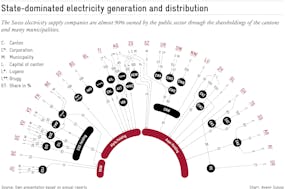Last year, electricity was in short supply, and prices in the electricity market skyrocketed. Rising prices signal a shortage ‒ for example, during hours of high demand and low production from renewables, and during crises such as the gas shortage resulting from the Ukraine war. However, most consumers in Switzerland have little incentive to respond to these price signals, as they are supplied by their electricity utility (EVU) at a price set the previous year. If voluntary savings are not sufficient to bridge shortages, the only option in an emergency is therefore for the power provider to disconnect.
The current market design thus suppresses both the incentive for load shifting (from expensive to less expensive hours) and the incentive for voluntary load reductions (when prices are consistently high during crises). The current system is therefore ill-suited to support the transition to a sustainable energy supply with renewables.

Price incentives can be strengthened by having utilities offer their customers a profile contract instead of fixed price contracts. (sru, Avenir Suisse)
Improving price incentives through profile contracts
Three ideas for improving market design are outlined below. First, price incentives need to be strengthened. This can be achieved if power providers offer their customers a profile contract instead of fixed price contracts. In the profile contract model, the customer purchases a defined load profile (= purchased profile) at a fixed price (e.g., the long-term average price) that corresponds to their consumption profile (see figure). For their excess consumption (compared with the purchased profile) the customer pays, and for their underconsumption they receive a refund equal to the spot price. The average price paid is very close to the fixed price, provided that the consumer’s load profile matches the profile they purchased and does not systematically exceed it during high-price hours. Profile contracts therefore protect consumers from sudden price increases, similar to fixed prices.

At the same time, however, consumers with a profile contract have the same incentive for short-term load shifting and medium-term load reduction as if they were supplied at wholesale prices (see table). Compared with today’s fixed-price contracts, consumers who limit their load or shift it from expensive to cheaper hours can achieve significant savings, especially during shortages. They do not have to accept a significantly higher price risk in return. At the same time, the utilities also benefit: the load profile they have to hedge is already known in advance and can therefore be hedged much more easily on forward markets. In terms of the resulting incentives, profile contracts are superior to supply at fixed prices or wholesale prices.

Tailor-made, individual supply security
The second idea is based on the following fact: The subjective value of an uninterrupted power supply from the grid varies greatly ‒ both between customer groups (e.g. households versus hospitals) and among load types (e.g. computers versus heat pumps). This should be taken into account. Today, in the event of a shortage, the federal government’s management ordinance allows for blanket bans on certain terminal equipment, uniform quota rates for large consumers and ‒ as a last resort ‒ rolling disconnections of various subnetwork areas.
But there are ways to control disconnections much more individually, namely by installing smart meters and connecting charging stations and other end devices to the ripple control system (or the Internet of Things). In the event of a shortage, it is efficient if customers can decide for themselves what level of supply security they require for their consumption as a whole or for specific end devices. Similar to choosing a maximum amount of coverage in the event of a claim when taking out insurance, consumers could specify when signing a contract the maximum price level up to which they want to maintain their total demand or parts of their demand ‒ for example, for certain end devices ‒ and pay a correspondingly lower price for this compared with a (near) 100 percent supply.
Power providers could already offer such contracts today. However, they have little incentive to do so, since they are allowed to restrict the consumption of loads in critical supply situations even without compensation. In the future, such restrictions should be limited to exceptional situations such as force majeure (e.g., sabotage). In all other situations, customers should receive compensation from their power providers. This would give the power providers an incentive to identify less valuable loads among their customers in advance, to secure them via more favorable contracts, and to be able to switch them off if necessary.
Automated load control according to preferences
The third idea for improving market design would be to make it as easy as possible for consumers to respond to the price of electricity. It would be most efficient to automate load shifts and load reductions within parameters preset by customers. This would allow consumers to specify the desired level of supply for individual end devices. The device control system would then calculate the tolerable deviation in each case and automatically control the device: it would throttle the supply or even switch off the device if certain price thresholds were exceeded. For customers, this would be much more convenient than constantly monitoring electricity prices and manually switching off individual devices when prices rise.
Depending on the customer’s preference, load control can be performed in different ways: by customers themselves (or their home automation system), by a power provider commissioned to control the load of all appliances, or by several providers commissioned to control the load of specific appliances. The latter could control the devices much more efficiently, since they have detailed knowledge of manufacturer-specific technical parameters. This also minimizes the risk of damage to the controlled devices. In the future, it is conceivable that appliance manufacturers could also sell a usage subscription that includes the level of energy supply selected by the customer, optimized control and servicing of the appliance. The prerequisite for individual load control, however, is not only a massively improved data situation, but also a more far-reaching opening of the market that allows end customers to choose an independent power provider on the free market for the most important flexible loads.
Power system becomes more resilient and reliable
The combination of price incentives, individual supply levels, and automated load control depending on electricity prices has a major advantage: supply gaps in the event of shortages can be closed at any time by throttling the least valuable loads. An administered load-shedding procedure, i.e., a controlled power cut-off as the last possible measure, would hardly be necessary in the case of supply-side shortages. The costs in the event of a shortage would decrease, and the power system would become more resilient and thus more reliable.
This article by Christian Winzer and Patrick Dümmler was published in the magazine “Die Volkswirtschaft” on June 19, 2023.





